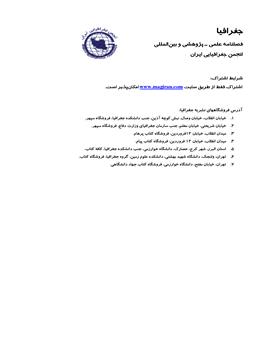Spatial Analysis of Development in Rural Areas of Semnan Province Case study: Damghan city
Subject Areas :Abdolreza Rahmani Fazli 1 , farhad azizpour 2 , 3
1 -
2 -
3 -
Keywords: rural development spatial analysis F', ANP model, Damghan city,
Abstract :
Achieving the balance and reducing the inequality in rural settlements requires studying and identifying the resources and facilities of these settlements. Indeed, spatial analysis of development identifies the inequality and deprivation of different areas and prioritizes actions to improve the quality of life. The present study is based on the purpose, applied and research method of descriptive-analytic. The required data are obtained using 29 indicators in various dimensions and by documentary method. The study area is Damghan and the statistical population of the study is all the inhabited villages of Damghan. The research indicators weighted using F'ANP model and data analyzed using VIKOR multivariable decision making method. Cluster analysis used in order to classify the studied villages, from the aspect of developmental levels and analysis of their inequalities, and linear regression used to analysis the effectiveness of the components (emphasized in the conceptual model) on the final index of development in the area of the study. The results of the study indicate that the development in rural areas of the study has not been uniformly and fairly. The spatial pattern of this situation has become unbalanced. In this pattern, population and facilities in some villages are overprovision and in the others are under provision. This has caused immigration, in particular among young people, and thereby eliminating the age and gender balance, undermining the economic foundations and raising unemployment rates. Also, this developmental inequality in the rural districts of Damghan city was most affected by two factors: "access to welfare services and the level of economic participation".
1. ازکیا، مصطفی و ایمانی، علی (1387)، توسعه پایدار روستایی، چاپ اول، تهران، انتشارات اطلاعات؛
2. بدری، سیدعلی؛ اکبریان رونیزی، سعیدرضا و جواهری، حسن (1385)، تعیین سطوح توسعه¬یافتگی نواحی روستایی شهرستان کامیاران، نشریه تحقیقات جغرافیایی، دوره 21، شماره 3، صص 130-116؛
3. توکلی¬نیا، جمیله و شالی، محمد (1391)، نابرابری¬های منطقه¬ای در ایران، مجله آمایش محیط، شماره 18، صص 16-1؛
4. زبردست، اسفندیار (1393)، کاربرد مدل F’ANP در شهرسازی، نشریه هنرهای زیبا- معماری و شهرسازی، دوره 19، شماره2. صص¬-38-23؛
5. سعیدی، عباس (1389)، ده مقاله در شناخت سکونتگاه¬های روستایی، چاپ اول، تهران، انتشارات مهرمینو؛
6. کلانتری، خلیل؛ ایروانی، هوشنگ و وفایی¬نژاد، شجاع محمد (1382)، سنجش سطح توسعه روستایی در شهرستان تربت حیدریه 79-1365. نشریه پژوهش¬های جغرافیایی، دوره 35، شماره 44، صص 54-41؛
7. عنابستانی، علیاکبر (1389)، نقش عوامل طبیعی در پایداری سکونتگاههای روستایی (مطالعة موردی: شهرستان سبزوار)، دوره 21 (2)، صص 104-89؛
8. مرکز آمار ایران، (1390)، سرشماری عمومی نفوس و مسکن؛
9. مرکز آمار ایران، (1395) سرشماری عمومی نفوس و مسکن؛
10. مرکز آمار ایران، (1393)، سرشماری عمومی کشاورزی؛
11. میرکتولی، جعفر و کنعانی، محمدرضا (1390)، ارزیابی سطوح توسعه و نابرابری ناحیه¬ای با مدل تصمیم¬گیری چند معیاره، مطالعه موردی:
سکونتگاه¬های روستایی استان مازندران، فصلنامه جغرافیا و آمایش سرزمین، سال اول، شماره دوم؛
12. Cziráky, D., Sambt, J., Rovan, J., & Puljiz, J. (2006), Regional development assessment: A structural equation approach. European Journal of Operational Research, 174(1), 427-442;
13. Galeotti, M. (2007), Economic growth and the quality of the environment: taking stock. Environment, Development and Sustainability, 9(4), 427-454;
14. Harpa, E., Moca, S., & Rus, D. (2016), A Comparative Study of Rural Entrepreneurship Romania–Greece. Procedia Technology, 22, 1100-1105;
15. Harrison, P., & Todes, A. (2001), the use of spatial frameworks in regional development in South Africa. Regional Studies, 35(1), 65-72;
16. Horlings, L. G., & Kanemasu, Y. (2015), Sustainable development and policies in rural regions; insights from the Shetland Islands. Land Use Policy, 49, 310-321;
17. Krimi, M. S., Yusop, Z., & Hook, L. S. (2010), Regional development disparities in Malaysia. Journal of American Science, 6(3), 70-78;
18. Losifides, T., & Politidis, T. (2005), Socio-economic dynamics, local development and desertification in western Lesvos, Greece. Local Environment, 10(5), 487-499;
19. Madu, I. A. (2007), Spatial Patterns and the Underlying Factors of Rural Development in the Nsukka Region, Southeastern Nigeria. Journal of Rural and Community Development, 2(2);
20. Martić, M., & Savić, G. (2001), An application of DEA for comparative analysis and ranking of regions in Serbia with regards to social-economic development. European Journal of Operational Research, 132(2), 343-356;
21. Ohlan, R. (2013), Pattern of regional disparities in socio-economic development in India: District level analysis. Social Indicators Research, 114(3), 841-873;
22. Pichs, R., Swart, R., Leary, N., & Ormond, F. (2000), Development, Sustainability and Equity. In Proceedings of the Second IPCC Expert Meeting on DES, Havana, Cuba. Available online at: www. ipcc. ch/pub/des. pdf (Accessed 24 August 2004);
23. Saxena, S. (2012), Problems faced by rural entrepreneurs and remedies to solve it. Journal of Business and Management, 3(1), 23-29;
24. United Nations, (1996), “Commission on Sustainable Development”, Economic and Social
25. Council, Report on the Fourth Session, New York;
26. Wackernagel, M. and Yount, J.D., (2000), Footprints for Sustainability, Vol. 2, No. 1, PP.
27. 23-44;
28. Zuindeau, B. (2006), Spatial approach to sustainable development: challenges of equity and efficacy. Regional Studies, 40(5), 459-470.


